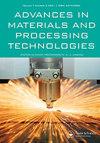Effect of silicon nitride nanoparticles on the microstructure, phase, hardness and wear properties of NiCrAlY-based nanocomposite
IF 2.1
Q3 MATERIALS SCIENCE, MULTIDISCIPLINARY
Advances in Materials and Processing Technologies
Pub Date : 2023-09-11
DOI:10.1080/2374068x.2023.2247282
引用次数: 0
Abstract
Despite the significant oxidation resistance of NiCrAlY alloy, one of the disadvantages of this alloy is its softness and poor mechanical properties, and low wear resistance. Therefore, in this study, silicon nitride nanoparticles have been used to improve the hardness and wear resistance of the NiCrAlY alloy. The present research has examined the effect of different amounts of Si3N4 nanoparticles (1, 3, and 5 wt.%) on the structure and mechanical properties of NiCrAlY alloy. The samples were characterised by scanning electron microscopy, X-ray diffraction, and Vickers microhardness device. Initially, Si3N4 powders with 1, 3, and 5 wt% were mixed with NiCrAlY powder in a mechanical mill. Next, the powdered mixtures underwent spark plasma sintering (SPS) operations at 1100 °C for 6 min. The results of microhardness measurements showed that adding 1% Si3N4 to NiCrAlY caused the elevation of the hardness from 418 to 614 HV. Further, the sample indicated a wear rate of 1.42 × 10−5 (m3/N.m) at room temperature, under a loading force of 9.8 N, and a sliding length of 500 m. However, with an increase in the weight percentage of Si3N4 in the sample from 1 to 5 wt%, the hardness diminished from 614 to 543 HV.氮化硅纳米颗粒对nicrali基纳米复合材料显微组织、相、硬度和磨损性能的影响
尽管NiCrAlY合金具有显著的抗氧化性,但该合金的缺点之一是其柔软性和机械性能差,耐磨性低。因此,本研究采用氮化硅纳米颗粒来提高NiCrAlY合金的硬度和耐磨性。本研究考察了不同数量的氮化硅纳米颗粒(1、3和5 wt.%)对NiCrAlY合金组织和力学性能的影响。采用扫描电镜、x射线衍射和维氏显微硬度仪对样品进行了表征。最初,在机械磨机中将含有1、3和5 wt%的氮化硅粉末与NiCrAlY粉末混合。然后,将粉末混合物在1100℃下进行放电等离子烧结(SPS) 6 min。显微硬度测量结果表明,在NiCrAlY中加入1%的Si3N4可使硬度从418 HV提高到614 HV。此外,在室温下,在9.8 N的加载力和500 m的滑动长度下,样品的磨损率为1.42 × 10−5 (m3/N.m)。然而,随着Si3N4在样品中的重量百分比从1 wt%增加到5 wt%,硬度从614 HV下降到543 HV。
本文章由计算机程序翻译,如有差异,请以英文原文为准。
求助全文
约1分钟内获得全文
求助全文
来源期刊

Advances in Materials and Processing Technologies
MATERIALS SCIENCE, MULTIDISCIPLINARY-
CiteScore
3.90
自引率
27.30%
发文量
222
 求助内容:
求助内容: 应助结果提醒方式:
应助结果提醒方式:


